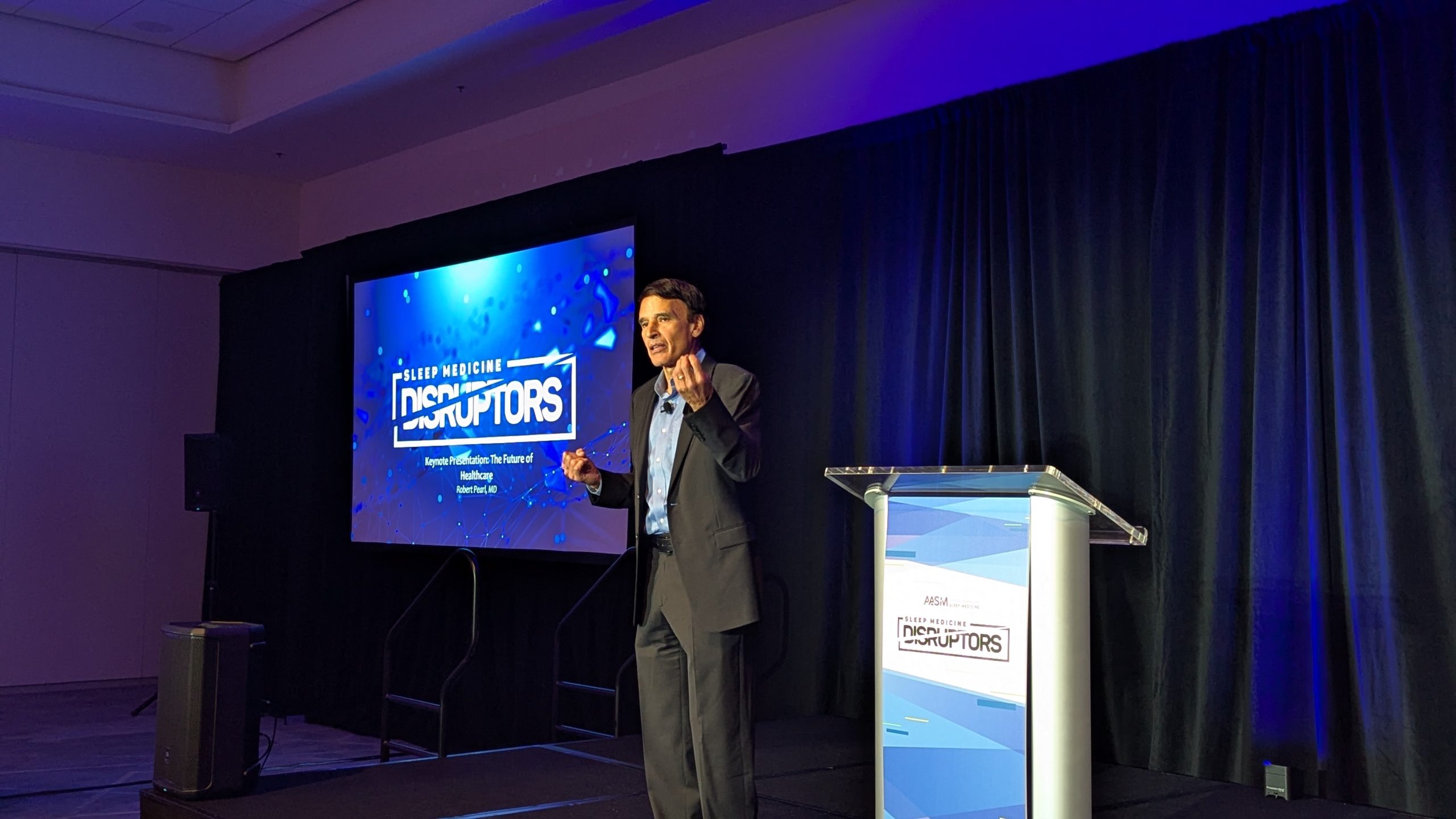
For as long as humans have dreamed, sleep has puzzled us. And even after nearly a century of research, it remains one of medicine’s great mysteries.
Why would evolution favor a state in which humans spend a third of their lives motionless, unproductive and vulnerable? Whatever the reason, one thing is clear: chronic sleep deprivation takes a devastating toll on health. It fuels heart disease, diabetes, depression and even premature death.
Having spent the past four years immersed in the evolving world of generative AI — as the author of ChatGPT, MD and through countless conversations with clinicians, technologists and policymakers — I’ve seen how this new technology can benefit myriad medical fields. Sleep medicine, I believe, will be one of them.
That was the message I shared as keynote speaker at this week’s Sleep Medicine Disruptors 2025 conference in Austin, Texas, hosted by the American Academy of Sleep Medicine and attended by hundreds of clinicians, scientists and healthcare innovators both in person and online.
Together, we explored how generative AI can help unravel the mysteries of sleep, improve diagnosis and treatment, and help millions of Americans become more rested.
The silent epidemic of poor sleep
Americans tend to treat sleep as optional, something we enjoy when we can but quickly sacrifice when life gets busy or stressful.
Yet research consistently shows that inadequate or poor-quality sleep increases the risk of cardiovascular disease, diabetes, anxiety, depression, and even cognitive decline. The nighttime can be fraught for patients who suffer from sleep apnea. Daytime can be dangerous for individuals with narcolepsy. And for millions of Americans, conditions like restless leg syndrome and chronic insomnia inflict pain, disrupt rest and diminish quality of life.
Despite these dangers, sleep medicine remains one of the most underutilized specialties in healthcare. Generative AI can bring this expertise and its benefits to all Americans.
Why current research and treatment methods fall short
Today, the most common diagnostic and research tool in sleep medicine is the overnight sleep lab. There, patients are monitored throughout the night as machines track brain waves, eye movements, muscle tone, heart rate, breathing (air flow and blood oxygen) and leg activity.
These studies generate hundreds of pages of data that experts must painstakingly review to identify patterns and deviations. The challenge is that each test reflects just one night, often spent in an unfamiliar environment far from a patient’s normal routine.
At the same time, millions of Americans now use wearable rings, bracelets and monitors to track their sleep at home. These devices offer a daily snapshot of sleep duration and quality. But they provide numbers, not diagnoses.
Bridging that gap between the lab’s precision and the wearable’s convenience is where generative AI shows great promise.
How GenAI will transform sleep medicine
Generative AI will revolutionize every field of medicine, and sleep science is no exception.
The transformation will unfold in stages: short-term advances that make current processes smarter and easier to accomplish, medium-term innovations that expand access, and long-term breakthroughs that deepen our scientific understanding of human health.
1. Short-term: Smarter sleep studies
In the near future, clinicians will use GenAI to facilitate the interpretation of sleep-lab data (just as cardiologists now use GenAI tools to analyze EKGs with remarkable accuracy). By training generative models on tens of thousands of expert-reviewed studies, developers can create tools that match or exceed human accuracy. Already, companies are working on these opportunities.
Soon, regulators will be able to test these systems head-to-head against clinicians, evaluating both accuracy and quality. Once proven to be superior, GenAI analysis would be approved by governing agencies to help speed up interpretation of data, reduce errors in diagnoses, and allow clinicians to focus on treatment.
2. Mid-term: Diagnosis at home
By combining visual, auditory and textual analysis (what scientists call “multimodal” capabilities), GenAI technologies will enable accurate, low-cost sleep assessments from home. Thus, instead of spending the night in a lab or wearing cumbersome monitoring equipment, individuals could be evaluated overnight (in their homes) using unobtrusive sensors that measure blood oxygen, pulse and blood pressure through the skin.
By integrating data from consumer devices and smart sensors, GenAI will be able to detect and quantify conditions such as sleep apnea, insomnia and restless leg syndrome, then facilitate timely clinical follow-up when needed.
This democratization of diagnosis will be especially valuable for individuals who can’t afford or access traditional testing. As costs fall, inequities tied to geography and socioeconomic status will shrink dramatically.
3. Long-term: Advancing sleep science
In the years ahead, generative AI will advance sleep research itself. These models will analyze datasets thousands of times larger than any human could manage and detect subtle relationships invisible to the human eye.
By combining sleep data with information on blood glucose, cardiovascular metrics and cognitive performance, GenAI can uncover how rest affects every system in the body. These models can quickly and inexpensively simulate interventions, test hypotheses and generate insights. Discoveries that once took a decade of study and millions in funding could soon emerge in days or weeks.
And beyond analysis, future tools can function as personalized “digital sleep coaches,” guiding patients through behavioral interventions, adjusting routines, recommending therapies and coordinating follow-up care.
For clinicians, GenAI will serve as an always-on colleague: synthesizing evidence, tracking treatment efficacy and ensuring continuity of care between visits.
Awakening a healthier future
As I told attendees in Austin, it’s no longer a question of whether generative AI will transform sleep medicine. It’s only a question of how quickly it will happen.
The tools now emerging will expand access to care, accelerate discovery, and empower both clinicians and patients to achieve healthier, more restorative sleep. In doing so, they will advance one of medicine’s most promising frontiers.
The Sleep Medicine Disruptors conference was aptly named. Too many Americans experience disrupted sleep night after night with profound, long-term consequences for health and well-being. If we want to help all Americans sleep well and face the next day refreshed, clinicians will have to embrace generative AI as a colleague and technological tool.
I’m grateful to Steve Van Hout, Executive Director; Thomas Heffron, Senior Director; and Erin Levine, Senior Meeting Planner of the American Academy of Sleep Medicine, for the opportunity to share these ideas and to learn from so many innovators working to move the field forward. Thanks, as well, to Dr. Azizi Seixas for his generous introduction and probing questions during the Q&A session.
As each participant returns home to their clinics, labs and classrooms, I hope they carry with them new perspectives, ideas for innovative tools and a renewed determination to help patients everywhere sleep more comfortably and live healthier.
* * *
Dr. Robert Pearl is the former CEO of The Permanente Medical Group, the nation’s largest physician group. He’s a Forbes contributor, bestselling author, Stanford University professor, and host of two healthcare podcasts. Check out Pearl’s newest book, ChatGPT, MD: How AI-Empowered Patients & Doctors Can Take Back Control of American Medicine with all profits going to Doctors Without Borders





